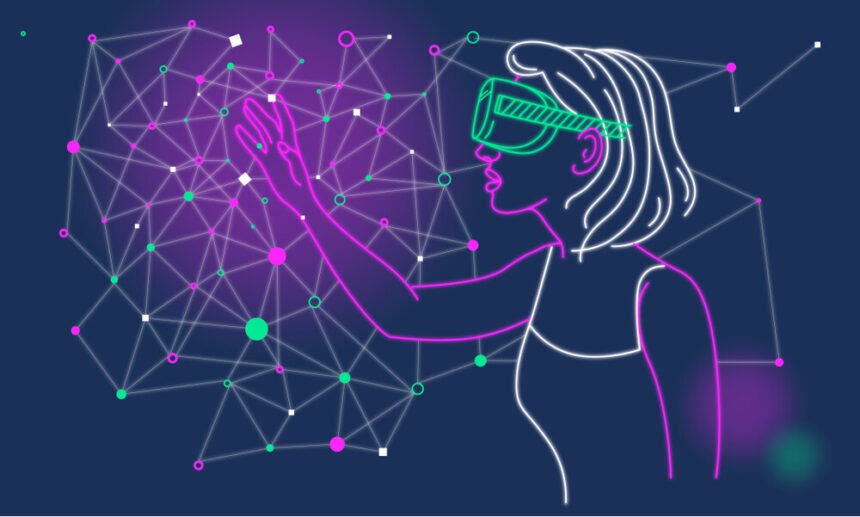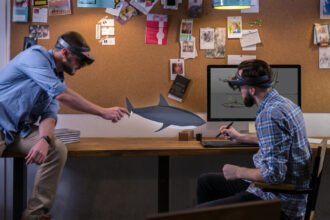Virtual reality (VR) is one of the most promising of today’s prominent technologies. While many conversations about the concept tend to revolve around the entertainment industry, companies are developing and implementing various types of VR across a range of industries.
In the future, it may prove challenging to find a sector that doesn’t use virtual reality in some capacity.
Once a thing of sci-fi imaginings, VR is now a prevalent part of life, and its uses will continue to grow. Future virtual reality will serve a myriad of roles for professionals of all markets.
What Is Virtual Reality?
VR can manifest in many different forms. Generally, however, it refers to using computers to generate a new, interactive environment. Video games are technically a form of VR, as they present a virtual world that users can manipulate. When people talk about VR, though, they’re usually referring to a more immersive format.
In one manner or another, virtual reality has existed since the 1950s, but the technology didn’t see widespread use until the ’90s. Since then, VR has become increasingly prevalent and versatile. While it continues to be part of gaming and movies, developers are discovering its potential in other markets, from manufacturing to healthcare.
Here are seven types of virtual reality that are shaping the future.
1. Semi-Immersive VR
Most of the time, when people think of VR, they picture fully immersive systems like the HTC Vive or Oculus Quest.
Unlike these technologies, semi-immersive VR offers users a mix of real and virtual interactive elements. At its most basic, semi-immersive VR is one of the oldest kinds of this technology, but today companies are applying it differently.
4-D movies may be the traditional use of semi-immersive VR, but now the technology is primarily used for education. Flight simulators involving a moving cockpit and simulated environment on screens allow pilots to train without the risks of flying a real aircraft. As VR technology improves, developers can produce similar systems for other complicated tasks or professions.
2. Augmented Reality
Like semi-immersive VR, augmented reality (AR) doesn’t fully immerse the user, but it differs in that it overlays virtual and real elements.
AR applications display computer-generated items over real-time images of physical environments. Some consider AR to be a separate technology from VR, but on a technical level, it falls under the umbrella of virtual reality.
AR shows a lot of promise for several industries. Online retailers can use it to project to-scale 3-D images of products onto the user’s home. AR goggles can help workers like technicians and plumbers by displaying instructions in the corner of their vision. Similar applications can help teachers make lessons more immersive for students.
3. Collaborative VR
Critics of VR claim it could lead to people becoming too immersed and thus isolated, but the technology can bring people closer together than before. Collaborative VR takes video conferencing programs like Skype to the next level.
This form of VR projects the same virtual environment to several users at once, no matter how far apart they may be. As a result, they can share ideas and work together on projects.
Collaborative VR can be as simple as a virtual conference room or as complex as an interactive 3D blueprint that engineers discuss and edit at the same time.
4. Manufacturing VR
One of the industries with the most to gain from VR is manufacturing. VR and AR technology can ensure safety and quality at every step of the manufacturing process, from design to inventory management.
Workers can use VR to train in simulated conditions before stepping onto the factory floor. With the right tools, they can decrease the risk of injury when they work with the actual machinery.
AR overlays help employees spot errors during quality control checks. Similarly, wearable AR tech will allow workers in inventory operations to identify parts and products more quickly than with the naked eye.
5. Medical VR
The field of medicine has a lot to gain from VR. In a business where accuracy and comprehensive approaches to problems are of utmost importance, virtual environments offer significant advantages across the board.
The most apparent of these benefits is that doctors and nurses can train in immersive simulations. Medical staff can use VR to practice surgery in a safe environment with real-time feedback.
These environments also prepare for any number of unique situations professionals might encounter. VR can create interactive digital models of the human anatomy that leads to a better understanding of different medical conditions.
Apart from training, virtual or augmented reality can assist patients in rehabilitation and recovery where traditional methods have fallen short.
6. VR Therapy
Physical health is not the only area of wellness that VR can improve. Treating patients who have psychological disorders can be a complicated process, but VR applications help psychiatrists and therapists explore previously unviable options.
Professionals often treat patients with phobias or related disorders with gradual exposure to the source of the issue — a process called systematic desensitization or exposure therapy.
VR allows these patients to undergo exposure therapy in a controllable, safe and private environment, increasing effectiveness and alleviating concerns associated with traditional forms of this therapy.
7. Mixed Reality
One of the most recent advances in VR is the concept of mixed reality (MR). MR is similar to AR in that it combines virtual and real elements. Unlike AR, however, the virtual components in MR interact with the real world, leading to an authentic affected VR experience.
Using technology like the Microsoft HoloLens, people can use MR to interact with 3D holograms in comfortable physical environments like their living rooms.
MR creates immersive tours and demonstrations, allowing students to gain a well-rounded understanding of a variety of concepts. Companies can use MR applications to generate unique and engaging team-building exercises for employees. Companies can use MR applications to generate unique and engaging team-building exercises for employees, which is super important for building strong relationships within the team.
The Future of Virtual Reality
No single form of VR will transform the world on its own. As a whole, however, the technology’s applications hold the potential to be one of the most disruptive concepts in the years to come.
Virtual reality is already changing the way some businesses operate. As technology further develops and people experience the benefits, VR will become a standard practice in nearly every sphere.











